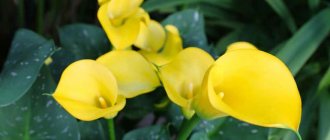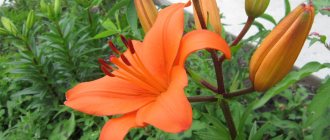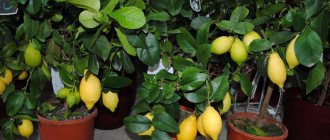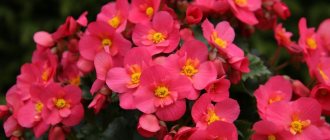Every gardener at least once in his life has had to deal with a situation where a luxurious indoor plant bought in a flower shop did not live up to expectations. Problems are more common in capricious, mature, exotic and flowering plants; but it is not always possible to preserve decorative foliage Spartans. The cause of death or loss of decorativeness is always fully or partially related to improper care at the initial stage (after purchase). After all, purchased indoor plants need smooth adaptation to a new home. And if you make mistakes in the initial care, the chances of successfully replenishing the collection will decrease tenfold.
Decorative plants in the interior of the room
There are many factors that affect a plant’s ability not only to maintain its beauty, continue flowering, or not shed its leaves in a new place, but also simply to survive. And most of them are not controlled by the grower in any way. Some flower centers often treat plants with growth inhibitors, use a combination of fertilizers and stimulants, and even constantly treat crops with fungicides and phytohormones, growing them in special conditions that allow them to maintain their decorative appearance and “marketable appearance.”
In this regard, many flower shops are no different from florists: here and there there are many secrets of preserving the freshness and beauty of plants, which stop working as soon as the plants move into the hands of the buyer. But even if we are talking about really loving and responsible flower shops with a good reputation, the conditions in them are still specific. The plants there are, in fact, in an environment similar to flower greenhouses. They are accustomed to stable and most often artificial lighting, high air humidity and frequent feeding.
In supermarkets, beautiful indoor animals do not receive the necessary care; in markets, they suffer from the vagaries of the weather. And always, when the plant finds itself in a typical environment for private houses and the above conditions cease, its true condition is revealed. And there are much more myths that plants are almost impossible to save than the real disadvantages of purchased crops.
There is no need to be afraid to buy plants. Most indoor plants used in the interior are not grown independently, but purchased. And if we still have green favorites in our homes, then preserving them is not such an impossible or problematic matter. First of all, you need to remember that you are not saving the plant, but helping it adapt to changes. You should not be afraid of myths about unviable transport soil, in which there seems to be no environment suitable for plants, or that they are treated with inhibitors or stimulants, or a radical change in conditions.
Even a plant weakened by forcing or overfed will survive with proper adaptation, but if it is not adapted, it is almost guaranteed to die. Therefore, the rules for primary plant care should not be violated, and it is better to strictly observe all requirements for conditions.
To adapt purchased indoor plants according to all the canons, you need to take care of three important components:
- About proper transportation and compliance with all standards for inspection and selection of plants.
- About primary adaptation in quarantine.
- About the beginning of systemic basic care.
Adaptation of purchased indoor plants. © Kieran Birchall
Time and rules for replanting indoor plants
In spring, all the plants wake up and begin to develop. It's time to replant indoor plants. Store-bought flowers can be replanted a month after purchase, or this work can be done in a few months. Home-adapted young plants are replanted every year in the spring, three-year-old plants - after two to three years.
Potting soil can be replaced:
- partially - the top soil layer 4-5 centimeters deep is removed;
- partially with plant transshipment;
- fully.
Partial replacement of soil is carried out every six months, this is especially necessary in containers with large plants. The top layer is carefully removed without damaging the thin surface roots of the flower, and topped up with new soil of suitable composition. The surface is watered with settled water at room temperature.
The safest and most root-friendly method is transshipment. The capricious flower requires replanting in this way. At any time of the year, plants waddle over, their roots peeking out of the soil or from drainage holes. The earthen lump dries out a little, the pot is slightly crushed, the lump with roots is stretched out and rolled into a new pot 2 centimeters wider than the previous one. New soil is added to the edges of the root ball, compacted, and watered.
Complete soil replacement is done when nutrients are depleted. Many people doubt whether it is worth touching the rhizome when replanting. Definitely worth it. To do this, the plant is completely removed from the pot, washed, and the roots are examined. Damaged, dried out, diseased root threads are removed. The container is selected to be 3-5 centimeters larger than the previous pot. The soil mixture should be matched in composition to the type of flower.
Soil acidity
Soil for gloxinia - what kind of soil is suitable for a flower
The suitability of the substrate for indoor plants is characterized by such an indicator as acidity. The essence of this parameter is the following - displaying the content of hydrogen ions (pH). For neutral or alkaline soil, the pH corresponds to 7. Indicators below mean acidification of the soil, and an increase in pH means an increase in alkalinity.
Important! Purchased mixtures always indicate the acidity of the substrate. In general, indoor plants prefer neutral and slightly acidic soils. But there are also specimens that like a more acidic environment.
Flower growers should know which indoor flowers love acidic soil. The list is provided below:
- azalea;
- ferns;
- hydrangea;
- camellia;
- monstera;
- anthurium.
Measuring soil acidity
In addition, you should know which trees and bushes like acidic soil. These include viburnum, blueberry, rhododendron, raspberry, buckthorn, and Japanese quince.
Slightly acidified, almost neutral ones are preferred:
- asparagus;
- amaryllis;
- begonia;
- pelargonium;
- tradescantia and many others.
Plants that love alkaline soils:
- rose;
- chrysanthemum;
- cineraria.
Replanting purchased plants
There are subtleties to replanting purchased plants. Before sale, the land is saturated with nutrients for lush growth and flowering. There is enough food for several months, so there is no need to rush to transshipment to a new land. It is worth finding and reading everything about the purchased flower, its nutritional needs, soil composition, and amount of watering.
During the first month, the new plant must adapt to the conditions of its new home. If the flower was purchased at a sale, you need to inspect the root system. To do this, carefully remove it from the pot and inspect the visible part of the root system. If there are damaged roots, remove them and treat the removal areas with charcoal (powder) or other protective agents.
The plant is placed back into a pot or container with a wider volume, and nutritious soil is added. The soil can be prepared at home or a ready-made soil mixture can be purchased at the store. After transplanting, water the flower and place it in a transparent bag or cover it with a transparent packaging cap from the cake.
Soil characteristics
In order not to make a mistake with the choice of soil, you need to know its main characteristics and correlate them with the requirements of a particular type of substrate.
The main characteristics of the soil include:
- porosity and looseness of the soil, which determine air penetration (soil aeration);
- ability to pass moisture (moisture permeability);
- ability to retain moisture (moisture capacity);
- nutrient conductivity;
- acidity level - pH. If Gloxinia, Hydrangea, Dieffenbachia require a slightly acidic environment (pH 6.0–6.5), then Rose, Cineraria, Chrysanthemum require a neutral environment (pH 6.5–7.0), and a slightly alkaline environment is suitable for Adenium and Narcissus. As a rule, the pH is indicated on the soil package.
Selection of pot
The pot is selected according to size and volume. The material from which the container is made is taken into account. Its size is chosen wider and deeper by 4-5 centimeters. To calculate the volume of the required pot, you can add 10% to the previous one when replanting.
Plastic pots are lightweight, and small plants can be replanted in them, as well as young pagons and shoots for propagation. Tall plants should be replanted in clay or ceramic containers that are heavy and stable. Clay and ceramic pots need to be washed well, doused with boiling water, and soaked overnight.
Ceramics or plastic
Proponents of clay pots focus on the porosity of the material. This allows air to move freely, excess moisture evaporates, and harmful salts do not settle into the soil. Such pots have a very impressive mass, which prevents them from accidentally falling from a draft or a naughty animal. Ceramic containers are very durable.
Plastic pots are much cheaper than ceramic ones. They are easy to wash and clean, they are not heavy. And the varied color range of plastic products allows you to match them to any interior and create original color compositions.
When choosing a material, you should remember that the porous structure of clay pots cools the surface due to the evaporation of moisture. Therefore, for heat-loving plants, such containers will need to be additionally insulated. The disadvantages of ceramic pots include the fact that hard water causes unsightly salt stains to appear on the clay.
How to get rid of stains on ceramic surfaces:
- wipe the container with potato peels, then rinse thoroughly and let dry naturally;
- stir a little detergent in the water, lower the pot into the solution for a quarter of an hour. Go over the entire surface with a stiff brush. Dissolve 1 part bleach in 10 parts water and rinse the pot with it. Rinse thoroughly with water and dry.
Flower pots are also made from ceramics. This product serves only as decoration; planting plants in it is prohibited. Because a completely glazed surface does not allow the plant to breathe. Also, the pots do not have drainage holes.
Plastic pots:
- retain moisture for a long time - it is necessary to control the frequency of watering and correctly calculate the amount of fertilizer. In such products, suppuration of the root system may begin;
- plants in plastic containers should not be left in the bright rays of the sun - overheating of your green pet is possible;
- Light-colored plastic pots are preferable because they repel excess heat.
Soil mixture composition
The soil is selected according to its composition for each plant; it must be sufficiently loose and nutritious. You can buy a ready-made mixture in a specialized store, or you can prepare it at home. The main components are soil, sand, peat, and nutritional components. For the base, turf, leaf, coniferous or soil from a compost heap is used.
Turf soil is taken in the spring from areas where wild grasses or legumes grow. To do this, remove a ball of turf 10 centimeters thick with a shovel and cut it into cubes. The cubes are folded with grass inside, into a container or wrapped in film. During the year, the soil needs to be turned over at least once and covered for the winter. It can be used next spring.
For leafy soil, you need to go to the forest or forest belt where linden, maple, and acacia grow. You should not take soil from under an oak or chestnut tree; it contains many substances that are unsuitable for replanting indoor plants. You can prepare leaf soil yourself if you have your own plot of land. Fallen leaves are collected in a heap and protected from drying out.
The layer thickness should be 1-1.5 meters, mixed with pieces of bark and thin branches. During the year, the pile needs to be turned over several times to ensure uniformity, and covered for the winter. After a year it is suitable for use.
Coniferous soil is collected under trees along with pieces of bark and twigs. It is mixed throughout the year and sheltered for the winter. It is used for flowers that love soil with a high acidity level. Soil similar in use is collected in the heather germination zone.
Only well-rotted soil is taken from a home compost heap, a year or two after the heap was laid. This valuable organic fertilizer makes up a small part of the components of the replanting soil.
To replant indoor plants, you need to create a certain soil composition. This can be done at home by looking up the required dosage on websites. To do this, you need to enter the name of the plant (even the popular name is used), and find detailed information about this species on the website.
There is also a detailed description of the soil composition, tips and rules for replanting.
Before planting or replanting a flower, the soil must be disinfected.
- To do this, you can use a container with small holes in the bottom. Place the soil in it and pour boiling water over it.
- If the soil is harvested in the summer, you can fry it in the bright sun under glass, covering it with black film.
- You can also use the drug “Fitosporin”, which destroys bacteria and fungi and saturates the soil with beneficial microorganisms.
- The soil prepared in the fall is frozen in severe frosts, spread out in a thin layer on any surface.
- You can fry the soil in the oven, but it will lose some of its nutrients.
You should not use chemicals for disinfection; this method can harm not only the flowers, but also those living in the apartment.
To loosen the soil, roasted coarse-grained river sand, pieces of charcoal, polystyrene foam, and bark are added. In what proportions and how to correctly compose the components of the soil, you can read on the floriculture website.
Land treatment after disinfection
After the soil is disinfected by calcination or steaming, it contains not only harmful, but also beneficial microflora, so the treated soil needs to be introduced with beneficial bacteria and microorganisms.
With the help of the fungicide Fitosporin - M, you can restore the beneficial properties of the soil. The drug contains the bacteria Bacillus subtilis, which restores the soil by multiplying in it and also destroys diseases. It is necessary to water the soil with the solution and wait for the bacteria to multiply; this takes several weeks.
On a note! Fitosporin is available in the form of powder, liquid and paste.
The drug must be diluted with water. The dosage is as follows:
- To prepare the soil for indoor plants, 5 grams per 10 liters of water will be enough.
- for the paste solution you need to take 15 drops per 1 liter of water.
- To dilute liquid Fitosporin, 10 drops per glass of water is enough.
Phytosporin can be used both for the prevention of plant diseases and for soil restoration. In addition, it is safe for animals and humans.
Flower transplant
The time to transplant flowers is early spring. After the winter calm, the flowers wake up and begin to grow.
- Work begins with preparing the pot, soil, water for irrigation, drainage, and tools. Next, step by step, the plant is transplanted:
- The first step is preparing the pot. A clay or ceramic pot is soaked overnight before planting. The plastic is washed and dried.
- A 2-centimeter layer of drainage is poured onto the bottom of the container (expanded clay, brick, pieces of a broken pot).
- The plant is removed and the roots are inspected for damage or disease.
- The roots are carefully cleaned from the upper earthen clod. Eating is required, the roots are shortened. To do this, part of the root system is removed with pruners or scissors and treated with charcoal powder.
- Soil is poured into the pot, in a layer of 2 centimeters, and the roots of the flower are placed. The planting depth should be the same as before transplanting. All gaps are filled with moist soil.
- Knead the earth around the trunk with your fingers and add more sleep.
The flower is watered taking into account some rules:
- if the plant does not like moisture, it is planted in moist soil; it will need to be watered in a tray after 3-4 days;
- a flower that has shortened or cut damaged roots is watered after 5-6 days (the wounds on the roots should heal). Every day you can only refresh the leaves by spraying.
If everything is done correctly, the flower will become more magnificent and reward you with beautiful blooms. Link to step-by-step plant replanting:
Florist's lunar calendar
Flower growers are wondering why use the lunar calendar to care for plants, if there is a difference in the timing of replanting? Using the influence of the lunar cycle, you can reduce the stressful state of the flower during transplantation. For the transplant date, the time of sap flow during the waxing phase of the moon is used. The root system at this time is not so vulnerable, it tolerates replanting calmly, will develop in the new soil, and build up its system.
If a plant has thrown out flower buds, even if the moon phases are favorable, it should not be replanted.
Also, do not touch it during the dormant period, in winter. There are exceptions in the event of a broken trunk or pot, or if insect pests have settled in the soil. According to the phases of the lunar calendar, it is advised not only to replant the plant, but to water, propagate and care for it.
Transplant errors
When replanting indoor plants, gardeners make the same common mistakes:
- replanting work is carried out at the wrong time;
- the size and volume of the pot is selected incorrectly;
- the composition of the soil is not suitable for the type of flower;
- planting was carried out without drainage;
- transplant rules were violated.
You should avoid such mistakes, follow simple rules of care, and protect plants from stress during transplantation.
Experienced flower growers give advice on how to properly replant indoor flowers in pots. You need to use them, treat your flowers with love, talk to them while caring. Flowers feel good, bloom more luxuriantly and grow without causing problems.
Why do flowers from the store wither quickly?
The florists explained that the purchased flowers were quickly
houses wither due to improper care. ... It’s better to buy a cut flower product at a flower shop. Before placing the bouquet in a vase, renew the plant cuttings under water. Change the water twice a day.
Interesting materials:
Should you eat salt? Should I use convection when baking? Do eggs need to be stored in the refrigerator? Do you need to store old things? Do I need to boil the bark for orchids? Do I need to glue a protective glass on Gorilla Glass 5? Is it necessary to attach the first crown to the foundation? Do I need to change the battery in a quartz watch? Do I need to change the bag in a vacuum cleaner? Is it necessary to change the water in the heating system?











